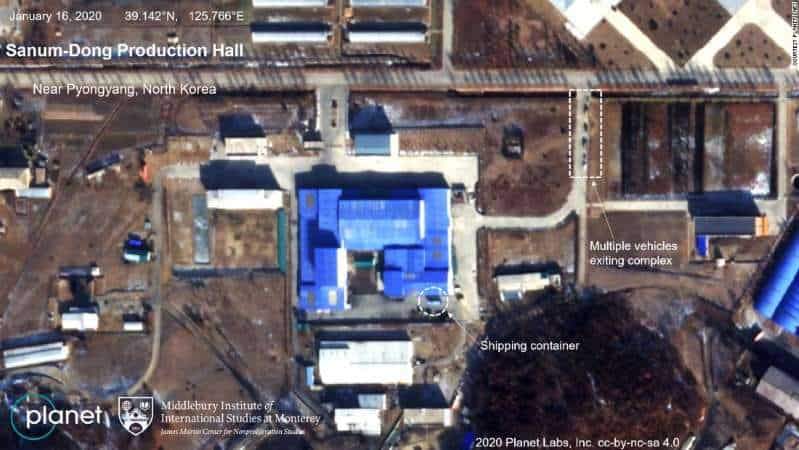Satellite imagery shows activity at critical North Korean missile site

Recent satellite imagery shows vehicle activity at a critical North Korean missile site that could potentially signal early preparations for a missile or missile engine test, according to one administration official and three defense officials familiar with the latest US assessment.
Vehicles have been seen at the Sanumdong missile research center near Pyongyang in recent days, the officials said. The vehicles are not believed to be involved in fueling missiles and US officials are not certain whether North Korea may be moving toward the launch of a short-or-medium-range missile or an engine test.
The "activities are consistent with what we've seen prior to other missile tests," one senior US official said. The officials, however, said there is no indication of an imminent test launch but added as always they cannot rule it out.
Intelligence analysts are not ready to rule out a test could be imminent, but the assessment is that North Korea would have to undertake several steps, including visible fueling, before launching a long-range missile. Sanumdong has been associated with the regime's long-range missile program.
Vehicle activity at Sanumdong has been intermittent in recent months. Researchers at The Middlebury Institute, who have monitored the site since 2017, told CNN the recent activity appears inconclusive and cautioned that the North Koreans are well aware their sites are monitored by US satellites so it could be part of an effort to mislead US intelligence.
"The unusual traffic is difficult to interpret. If it is a leadership visit to the factory, that could come either at the beginning or the end of the construction of an ICBM or space launcher," said Jeffrey Lewis, director of the Institute's East Asia Nonproliferation Project.
"The important thing is that there is an uptick in activity at the site, just as there has been at Sohae and other facilities," he added.
Recent commercial satellite imagery captured by Planet Labs and analyzed by experts at Middlebury Institute also shows a large blue shipping container at Sanumdong.
The contents of the container remain unknown but it first appeared at the site on January 9 and seems to have been regularly moved since that time. The container can be seen in images captured on January 9 and 10 but was not present in those taken just four days later.
The container reappears in images taken on January 16 but was gone by January 19.
The activity comes days after North Korean leader Kim Jong Un announced he would develop new "strategic" weapons in the face of what it called US "hostile policy."
Kim also said North Korea no longer felt bound by any self-imposed moratorium on nuclear weapons or long-range missiles testing -- a clear message aimed at President Donald Trump who has excused Pyongyang's testing of rocket engines and short-range missiles but cautioned against escalation beyond that point.
North Korea has insisted talks with the United States will not resume until all of its demands are accepted by Washington, and getting Pyongyang back to the negotiating table is likely to a significantly more difficult task than it was after Kim and Trump met for the first time in Singapore in June 2018.
While North Korea may be publicly blaming the Trump administration for the stalled talks, political calculations are also likely at play. A source familiar with the North Korean leadership's current mindset said last month that Pyongyang views Trump as politically vulnerable due to his impeachment and the looming 2020 presidential election.
Still, Trump's top officials have publicly expressed optimism that talks can be reopened and national security adviser Robert O'Brien said earlier this month that the administration has reached out to North Korea to resume diplomatic negotiations after the two countries broke off talks in October.
"We've reached out to the North Koreans and let them know that we would like to continue the negotiations in Stockholm that were last undertaken in early October," O'Brien said.
He added: "We've been letting them know, through various channels, that we would like to get those [negotiations] back on track and to implement Chairman Kim's commitment" to denuclearization of the Korean Peninsula.
Despite what top administration officials have said publicly, the US is still closely watching activity at Sanumdong. Defense Secretary Mark Esper warned Friday that North Korea maintains an "aggressive" weapons research and development program.
"Clearly they're trying to build long range ballistic missiles with the ability to carry a nuclear warhead," he said.
While Esper's comments echo warnings that have been issued by other top US national security officials for more than a year, the US intelligence community still believes North Korea has not fully refined its long-range capability.
That assessment is based on the regime's inability to demonstrate the full scope of guidance capabilities needed for a long-range missile to hit a target.
And while the White House and Pentagon still hope for a diplomatic breakthrough on denuclearization, the number two general in the Pentagon also recently sounded a note of caution.
"North Korea has been building new missiles, new capabilities, new weapons as fast as anybody on the planet," General John Hyten, vice chairman of the Joint Chiefs of Staff, said last week.
Photo: © courtesy Planet Labs




